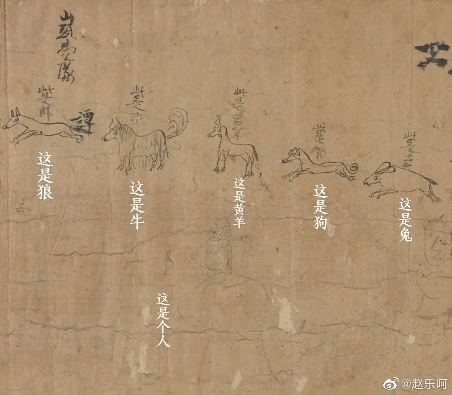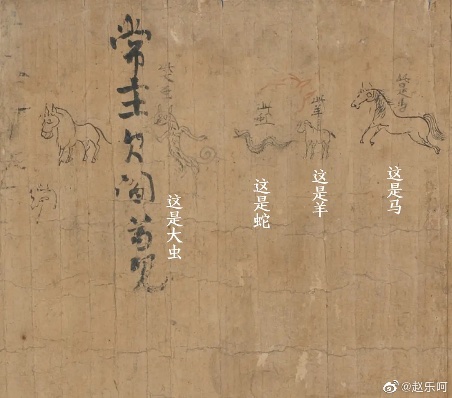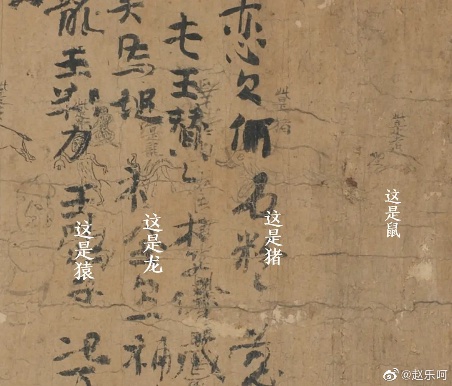Acquiring literacy in medieval Dunhuang
Language Log 2021-02-20
This semester, I'm teaching an advanced graduate seminar on Dunhuangology. Below, I will explain what that means, but first let me post photographs of one of the manuscripts from Dunhuang that we will be studying in the class:
Before describing the contents of the manuscript (scroll) pictured in the photographs, the most important thing is to give a very brief identification and description of Dunhuang.
Dunhuang is a key node on the so-called "Silk Road". It is located at the far western end of the narrow Gansu / Hexi Corridor that stretches roughly 1,000 kilometers (620 miles) from the western edge of the heartland of China near the city of Lanzhou. Dunhuang is an oasis city of 187,578 inhabitants that served as the jumping off point to the Western Regions (Xīyù 西域) in Eastern Central Asia. Aside from its strategic geographic location guarding the western approach to China, Dunhuang is famous for the Mogao Caves (Mògāo kū 莫高窟). All together, there are approximately five hundred cave temples at the site, decorated with an estimated half a million square feet of religious (mostly Buddhist) wall paintings and an abundance of sculptures. The most sensational find at the Mogao Caves, however, was a cache of approximately 50,000 manuscripts (scrolls, booklets, etc.) dating to between 406 and 1002 that was discovered in 1900. Around 13,000 complete manuscripts and fragments were taken to England by the Hungarian-born British archeologist Marc Aurel Stein, who visited the caves in 1907, and nearly another 10,000 were transported to Paris by the French scholar, Paul Pelliot, who carried out investigations at the caves in 1908. This is why the vast majority of Dunhuang manuscripts are designated with an "S" or a "P" before a number. Thousands more Dunhuang manuscripts are in Beijing and a substantial amount are in St. Petersburg, with smaller collections in Japan and elsewhere.
Here's a portion of the summary of the course.
The purpose of this seminar is to familiarize ourselves with all aspects of Dunhuang Studies (敦煌學): literature, art, religion, music, science and technology, language, history, social customs, etc., but especially manuscripts of all types and on all subjects (lay societies, law, economy, medicine, astronomy, and so on).
One of the goals of this seminar is to learn to read better and understand Middle Vernacular Sinitic (MVS) – Chinese scholars generally refer to this type of language as Zhonggu Hanyu 中古漢語 (“Middle Sinitic”); some Western scholars refer to it as Medieval Chinese. You are strongly encouraged to look into the files of the MVS dictionary (draft entries) edited by VHM and Zhu Qingzhi 朱慶之 (Peking University and the Hong Kong Education University) that are on Canvas.
Now, to turn our attention to the scroll pictured above, P2622 (Pelliot Dunhuang manuscript 2622). On the recto is a "Jíxiōng shū yí 吉凶書儀" ("Letter Models for Auspicious and Inauspicious Events"). This is a common type of text at Dunhuang, with 19 of them having been discovered in the cave library. On the verso, the most conspicuous content is a series of 13 simple sketches of animals and one of a man. The writing in white has been recently added. It consists of translations into modern Mandarin of the identifications of the figures which are written faintly next to the drawings.
The Mandarin translations all begin with "zhè 这 / 這" ("this"), the proximal demonstrative pronoun, which first appears in the Tang period (618-907) and is a sure sign of the vernacular. It is followed by "shì 是", which, oddly enough, in classical / literary usage was originally an anaphoric or indefinite pronoun, but, under the influence of Buddhist translations of Sanskrit texts, gradually evolved into the copular verb. This too is a sure sign of the vernacular, one that also occurred primarily during the Tang period. (Kroll [2015] 417a)
The original equivalent of modern Mandarin "zhè shì 這是" ("this is") on the manuscript is either "cǐ shì 此是" ("this is") or just "cǐ 此" ("this [is]"), the latter only a couple of times, though it is literarily / classically more correct. This ambiguity of usage is actually quite telling and is indicative of how vernacularisms were "contaminating" literary texts at this very time. I refer to this style, which was particularly noticeable during the late 19th and early 20th century under the impact of Western languages, as "bànwénbànbái 半文半白" ("semi-literary semi-vernacular) or more crudely as "bastardized literary / classical". In fact, it reflects the ineluctable evolution of the vernacular and its eventual replacement of the literary / classical.
Selected readings
- "slip(per)" (7/22/14) — especially this comment on the name "Dunhuang".
- Victor Mair, "Reflections on the Origins of the Modern Standard Mandarin Place-Name 'Dunhuang' — With an Added Note on the Identity of the Modern Uighur Place-Name 'Turpan'", in Li Zheng, et al., eds., Ji Xianlin Jiaoshou bashi huadan jinian lunwenji (Papers in Honour of Prof. Dr. Ji Xianlin on the Occasion of His 80th Birthday) (Nanchang: Jiangxi People's Press, 1991), vol. 2, pp. 901-954 (very long and detailed study).
[Thanks to Yijie Zhang, Selena Zhu, Tong Wang, and Chenfeng Wang]


